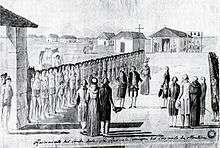Rumsen
The Rumsen (also known as Rumsien, San Carlos Costanoan and Carmeleno) are one of eight groups of the Ohlone, an indigenous people of California.

Territory
The Rumsen historically shared a common language, Rumsen, which was spoken from the Pajaro River to Point Sur, and on the lower courses of the Pajaro, as well as on the Salinas and Carmel Rivers, and the region of the present-day cities of Salinas, Monterey and Carmel.
The Rumsen tribe held the lower Carmel River Valley and neighboring Monterey Peninsula at the time of Spanish colonization. Their population of approximately 400-500 people was distributed among at least five villages within their territory.[1] An early twentieth-century mapping of a specific village called Rumsen on the Carmel River, several miles inland from the Mission in Carmel, may or may not be accurate.[2] Mission registers indicate that "Tucutnut", about three miles upstream from the mouth of the Carmel River, was the largest village of the Rumsen local tribe.[3]
History

The Rumsen were the first Costanoan people to be seen and documented by the Spanish explorers of Northern California, as noted by Sebastian Vizcaíno when he reached Monterey in 1602. Since this first Spanish contact, Manila galleons may have occasionally ventured up the California coastline and stopped in Monterey Bay between 1602 and 1796.[4]
.jpg)
During the era of Spanish missions in California, the Rumsen people's lives changed when the Spaniards came from the south to build the Mission San Carlos Borroméo de Carmelo and the Monterey Presidio in their territory. Many were baptized between 1771 and 1808. Once baptized, the Rumsen people were required to live in the mission village and its surrounding ranches, They were taught as Catholic neophytes, also known as Mission Indians, until the missions were secularized (discontinued) by the Mexican Government in 1834. Some Mission San Carlos Indian people were formally deeded plots at secularization, only to lose those plots during the Rancho Period.[5]
At least since the mission era, the people of the Esselen Nation claim close association with the Rumsen Ohlone, through Mission integration and intermarriage.
Rumsen-speaking tribes and Heritage
Dialects of the Rumsen language were spoken by four independent local tribes, including the Rumsen themselves, the Ensen of the Salinas vicinity, the Calendaruc of the central shoreline of Monterey Bay, and the Sargentaruc of the Big Sur Coast. The territory of the language group was bordered by Monterey Bay and the Pacific Ocean to the west, the Awaswas Ohlone to the north, the Mutsun Ohlone to the east, the Chalon Ohlone on the south east, and the Esselen to the south.[3] Linda Yamane is an Ohlone scholar and basket weaver who traces her heritage to the Rumsen Ohlone. She has spent over thirty years researching and reviving Rumsen language, stories, songs, basketry and other Ohlone cultural traditions.
Notes
- Breschini and Haversat 1994
- Kroeber, 1925, Map p. 465
- Milliken 1987
- Levy 1978:486; Teixeira 1997:15.
- Hackel 2005
References
- Breschini, Gary S. and Trudy Haversat. 1994. Rumsen Seasonality and Population Dynamics. In The Ohlone Past and Present, pp. 183–197, Lowell J. Bean, editor. Menlo Park, CA: Ballena Press.
- Hackel, Steven W. 2005. Children of Coyote, Missionaries of Saint Francis: Indian-Spanish Relations in Colonial California, 1769-1850. University of North Carolina Press. ISBN 0-8078-2988-9
- Hinton, Leanne. 2001. The Ohlone Languages, in The Green Book of Language Revitalization in Practice, pp. 425–432. Emerald Group Publishing ISBN 0-12-349354-4.
- Kroeber, Alfred L. 1925. Handbook of the Indians of California. Washington, D.C: Bureau of American Ethnology Bulletin No. 78. (map of villages, page 465)
- Levy, Richard. 1978. Costanoan, in Handbook of North American Indians, Vol. 8 (California). William C. Sturtevant, and Robert F. Heizer, eds. Washington, DC: Smithsonian Institution, 1978. ISBN 0-16-004578-9 / 0160045754, pages 485-495.
- Milliken, Randall. 1987. Ethnohistory of the Rumsen. Papers in Northern California Anthropology No. 2. Salinas, CA: Coyote Press.
- Teixeira, Lauren. The Costanoan/Ohlone Indians of the San Francisco and Monterey Bay Area, A Research Guide. Menlo Park, CA: Ballena Press Publication, 1997. ISBN 0-87919-141-4.
External links
- Costanoan Rumsen Chino Tribe
- Ohlone Costanoan Esselen Nation tribal website
- "Rumsen / Southern Ohlone sound recordings". Collections Search Center, Smithsonian Institution. Retrieved 2012-07-20.